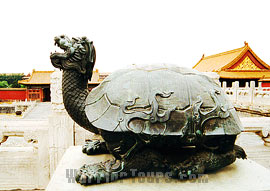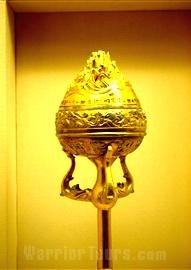Bronzes
 Bronze, one of the great inventions in human history, is an alloy of copper, tin, lead and other chemical elements, and it was so named because of being caesious (meaning bluish or greyish-green). It was the earliest alloy in the world's history of metalworking; China appears to have always experienced a Bronze Age (a period when bronze was widely used in people's daily life), one lasting for 16 centuries. The bronze vessels of China take their place among collections of sculpture, painting, and many other arts; they are gems of the cultural relics in China and the essence of the world's art history.
Bronze, one of the great inventions in human history, is an alloy of copper, tin, lead and other chemical elements, and it was so named because of being caesious (meaning bluish or greyish-green). It was the earliest alloy in the world's history of metalworking; China appears to have always experienced a Bronze Age (a period when bronze was widely used in people's daily life), one lasting for 16 centuries. The bronze vessels of China take their place among collections of sculpture, painting, and many other arts; they are gems of the cultural relics in China and the essence of the world's art history.
![]() Bronze Culture
Bronze Culture
Bronze was used in Chinese people's life as early as six to seven thousand years ago. The earliest bronze vessel known now in China is a bronze knife discovered in the Majiayao Culture of Gansu Province. The knife is simply decorated and, reflects the rustic, aesthetic sense of the ancient Chinese.
Bronze appeared in the Longshan Culture period, about 4,000 years ago. From the Xia Dynasty (21st – 16th Century BC) until the early period of the Warring States Period (475 BC – 221 BC), bronze work was a feature of prosperous times.
For instance, under the Xia Dynasty – Bronze ritual vessels symbolizing ranks and status appeared.
Likewise, during Shang Dynasty (16th – 11th Century BC) – a prosperous and flourishing age for bronze-work; large bronze vessels with delicate patterns were made in large numbers.
In the Zhou Dynasty (11th – 221 BC) – bronze vessels with long inscriptions appeared, which are valuable historical references. The design and style of the bronze vessels were changed with subtlety and freshness, and most bronze vessels are full of local characteristics and living color.
From the Qin Dynasty (221 BC – 206 BC), bronze vessels were gradually replaced by iron vessels, and the kinds, formations and decorations of the bronze vessels were all greatly changed. Bronze ritual vessels reduced in size and quantity, while bronze coins, weighing and measuring instruments and mirrors became the mainstream in China's feudal society. During the Sui and Tang Periods (581 - 907), bronze vessels in China were only limited to mirrors. Hereafter, bronze has been hardly used in China.
![]() Bronze Vessels
Bronze Vessels
Among the bronze vessels, those in the Shang and Zhou Dynasty are the most exquisite. The earliest ones are mainly some small-sized tools and decorations. Later, they were developed into ritual vessels, musical instruments, water vessels and many other categories.
![]() Tripod:
Tripod:
an ancient cooking vessel for boiling and storing meat, it is classified into tripedal and four-footed ones or lidded and lidless ones. In ancient times, the number of the tripod symbolized different social status, and nine tripods represented vassal, five and seven tripods for minister and senior official, one and three tripods for scholar-bureaucrat. In 1939, the Simuwu Rectangle Ding was excavated in Yin Ruins, Henan Province. It is the biggest bronze vessel in the archaeological finds of the world.
![]() Drinking Vessels:
Drinking Vessels:
as a necessity for feasting guests, making sacrifices to ancestors, and friends gathering at a party, drinking vessels are a kind of ritual vessel. There were a variety of bronze drinking vessels during the Bronze Age like birds-shaped Jue that is a kind of ancient wine holder with three legs and loop handle, triangle-shaped Jiao that is a vessel for heating wine, and Gu that is a vessel for drinking wine, lidded and four-footed with a square-shaped base.
![]() Food Wares:
Food Wares:
it is also a kind of ritual vessel for cooking and storing food. People of different ranks often used different food wares in ancient China. The most common ones are Guis that is a round basket of bamboo for storing millet, and matching with the tripod, two, four, six and eight Guis represented different noble ranks. The other one is Dou, and is for holding dry fruits and fried pork crisps.
![]() Water Vessels:
Water Vessels:
Jian is one of the important and common water vessels, and it is a big basin, which can be earless, two-eared or four eared. It has three kinds of use, one is for bathing, secondly, to store water for seeing oneself by reflection, and the last is for storing ice. It is also a kind of water vessel for pouring water into a basin when washing hands and face.
![]() Musical Instruments:
Musical Instruments:
the earliest one is a bronze bell dating back to four thousand years ago. The Bronze Rao, bell, drum, Bo, and Chun were also popular musical instruments in ancient China. The Bo is a kind of percussion instrument performing singly the Rao was the special instrument used in royal and vassal families, and the Chun is a military instrument used together with a drum.
![]() Weapons:
Weapons:
most of the bronze weapons are very primitive. The most common one is a tomahawk, a kind of torture instrument for killing. The other is a dagger developed from the harvesting knives. The spear is another example, and was the longest weapon used by cavalries.
![]() Measuring Instruments:
Measuring Instruments:
These were bronze rules for measuring length and bronze scales for measuring weight and are the representatives here.
![]() Bronze Mirrors:
Bronze Mirrors:
most of the bronze mirrors excavated are round-shaped featuring geometry, birds or animal patterns on the back. During the Tang Dynasty, bronze mirrors reached their peak; all kinds of bronze mirrors were made in large numbers, with a colorful style and high level of technique. Since then, Bronze mirrors gradually disappeared from people's lives.
![]() Others:
Others:
these are chiefly some daily utensils such as bronze lamps, stoves, incense burners, combs, hussif, filters and some decorations inscribed on constructions.
There are many interesting books written in the Chinese language (as well as many other languages) along with beautiful illustrations and photographs, about Chinese bronzes and associated artifacts that can be purchased for further studies of this all-important and fascinating topic of Chinese culture.


